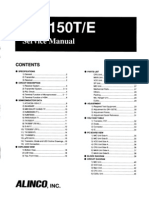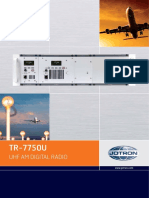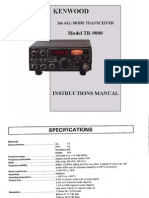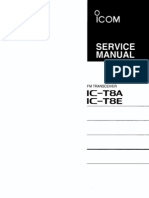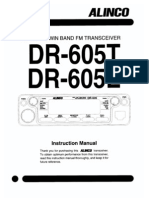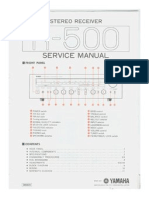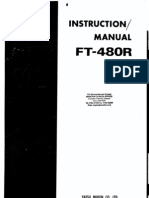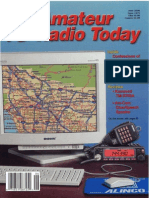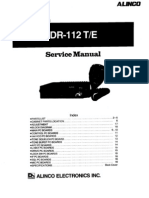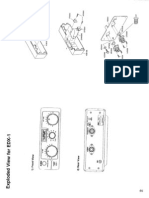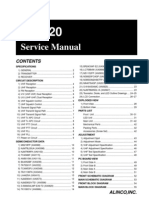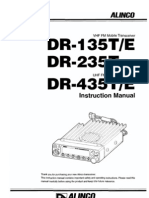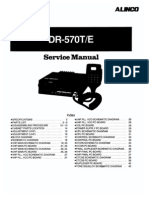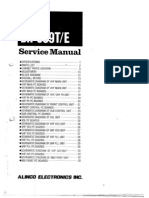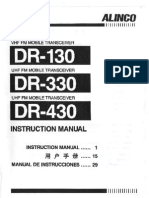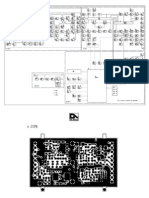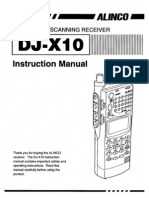Professional Documents
Culture Documents
Kenwood TR-7500 Instructions Manual
Uploaded by
Yayok S. AnggoroOriginal Description:
Copyright
Available Formats
Share this document
Did you find this document useful?
Is this content inappropriate?
Report this DocumentCopyright:
Available Formats
Kenwood TR-7500 Instructions Manual
Uploaded by
Yayok S. AnggoroCopyright:
Available Formats
INTRODUCTION
Your KENWOOD Model TR-7500 is a high-quality 2-meter transceiver for use in amateur radio mobile stations as well as fixed stations.
The TR-7500 offers the following features:
o A wide coverage of 40 channels by the adoption of the PLL circuit.
o Channel indication with LED's.
o +600 kHz shift circuit incroporated.
o Adoption of the ULI circuit for the prevention of misoperation.
o R F A TT switch provided.
o Tone switch for repeater operation provided.
o Transmission output HI-LOW changeover switch provided.
o Receiving sound quality changeover filter incorporated.
o Various indicators with LED's.
CONTENTS
SPECIFICATIONS
3
SECTION 1 PREPARATION FOR USE. . . . . . . . . . . . . . . .. 4
1.1 Accessories 1.2 Antenna
1.3 I nstallation Caution
SECTION 2 CONTROLS AND WHAT THEY DO. . . . . . . . .. 4
2.1 Front Panel
2.2 Rear Panel
2.3 Side Panel
SECTION 3 GENERAL TIPS ON INSTALLATION 7
3.1 Mobile Use
3.2 Fixed Station Use
SECTION 4 OPERATION ...•...................... 9
4.1 Receiving
4.2 Transmitting
4.3 How to Use the Hi/Low Switch
4.4 How to Use the Mode Switch
4.5 How to Use the Tone Switch
4.6 Notes. on the ULI Indicator
4.7 Channel Table
4.8 Repeater Operation
4.9 How to Use the R F ATT Switch 4.10 How to Use the Center Meter
SECTION 5 ADDITIONAL INFORMATION . . . . . . . . . . . .. 11 TOP & BOTTOM VIEW OF THE TR-7500 . . .. . . . . . . . . . .. 12
SCHEMATIC DIAGRAM , . . . . . . . . .. 13
BLOCK DIAGRAM 14
,a.fl1 ..... UII.,·.IIID·.IIH.,· .. IID·UIII.,·.IHI.·.III .... UIU·nlll.,·.lnn·.1111 .... 1111.,·41111.·.111.· .... .,·41 ••• ., .. 0 ... ·.111 .. ·.110.,·."".,·.1I1P-.II ... ·.lllp·.IIII.· .. III ... IIII ... IIII.,·.IIII., •• III., •• IIII., •• 1111 ..... II ... IIID •• IIII., •• HI .... IIII •••• I1~
I TR-7500 SPECIFICAT10NS I
~U"., .. H"., .... II., •• III .... Hn •• '"II ••• IIII ... IIII ••• II ..... IIII ••• IIII ..• 111 .. • ... II.·41III ... IIII.·."II.·.III .. • ... U.·.IIIO· ...... ·.IIII.·.'111 ... '111.·11111.·.111 .... 1111 ..... "., ••• 111., •• 1111 ••• 1111 ••• 111 .... '111".IIII".IIII ... OII".IIII".OIl"OIIlJ
GENERAL Semiconductor
Transistors FETs
ICs
44 8 7
Dimensions
Diodes 36
145.000 MHz to 145.975 MHz Digital control of phase locked VCO Less than ,± 750 Hz at 25°C
FM
40 channel (25 kHz interval) -20 to +60°C
11.5 VDC to 16.0 VDC (13.8 VDC as reference) Negative grounding
50 n
Less than 0.5A in receive with no input signal
Less than 3.0A in transmit (H I)
Less than 1.5A in transmit (LOW)
(at 13.8 VDC)
152 mm width
60 mm high
234 mm deep
Approx. 2.2 kg
Frequency Range. . . . .
Frequency Sy nthesizer . Synthesizer Stability .
Mode .
No. of Channel Operating Temperature Power, Voltage
Grounding
Antenna Impedance.
DC Current .
Weight ..
TRANSMIT SECTION
R F Output Power . . .....
High 10 watts (rnin.)
Low approx. 1 watt (adjustable up to, 5 watts)
Variable reactance direct shift
±5 kHz
Less than -60 dB 1750 Hz
. Dynamic microphone with PTT switch, 500n
Modulation
Max. Frequency Deviation .. Spurious Radiation . . . . . . .
Repeater Tone Frequency .
Microphone . . . . . . . .
RECEIVE SECTION
Circuitry .
Intermediate Frequency ....
Double superheterodyne
1st IF 10.7 MHz
2nd IF 455 kHz
Less than 0.4 p.V for 20 dB quieting (Less than 1 p.V for 30 dB SIN) Less than 0.25 p.V
More than 12 'kHz at 6 dB down
More than 70 dB at 25 kHz of adjacent channel More than 70 dB
More than 60 dB
More than 66 dB
More than 1.5 watts across 8 n load (10% distortion)
Sensitivity .
Squelch Sensitivity . Pass Band Width .. Selectivity (2 Signal) Image Rejection ... Spurious Interference Intermodulation Audio Output ....
Note: The circuit and ratings may change without notice due to development in technology.
.. 1I IIII ••• II ., -uun« II m •• IIII •• ..-m OIll .,·.nm· ·olll.·uu .. ·mm·.IIII.·ulll.·.nm·mm·mm·.UlIJ·.UU UIlJ·UlIIJ·.1I11J·.IIIIJ· ·IIIU.· IIJ·mll nm· m·.lllu·.IIII.·mll ...
L."".""".""' """".~~~~'~~?~m'~":' .. .:.~,~~.~~~~!.?.~-~?~ .. ",~~.~.",""", .. , .. ,, .J
1.1 ACCESSORIES
Carefu Ily unpack the T R-7500 transceiver and check that the following accessories are included. (1) Dynamic microphone equipped with
4-pin plug . . . . . 1 piece
(2) Mounting bracket (3) Mounting parts
Screws, 6 mm diameter
Plain washers, 6 mm diameter. Spring washers, 6 mm diameter. Nuts, 6 mm diameter
(4) Stand-off bracket ...
(5) DC power cord with plug
and fuse .
(6) Spare fuse (4A)
(7) Miniature plug for external speaker (8) Miniature plug for center meter.
(9) Operating manual .
piece
4 pieces 4 pieces 4 pieces 4 pieces 1 piece
1 piece
1 piece
piece
piece
copy 1.2 ANTENNA
Any 50 ohm 145 MHz band antenna system may be used with your TR-7500. The 50 ohm coaxial cableshould be kept as short as possible in order to minimize line loss. Attach a UHF type connector (PL-259) to the coaxial cable for easy connection to the receptable on the transceiver.
1.3 INSTALLATION CAUTION
Your TR-7500 Transceiver to be operated as a mobile station should be securely mounted under the dashboard (or similar location) using the accessory mounting bracket and bolts. Improper installation will result in damage to the transceiver and dashboard. Consideration must be given to the dashboard material prior to installation. More detailed information on installation will be found in SECTION 3.1, the "MOB I LE USE", page 7.
:!1II .. ·.IIII.·.IIIIJ·.III .. • ... II.·UlIIJ·.UIU· ...... ·.III1J· ...... ·CIIll.·.UI .. ·UIm·mm·cllln·.llln.ulll •• cllll •• UIlU·UlIU.cllm .... m.clll ... ml~ •• clllU·CIIll.·.IIII.·UIII •• mm·411I1NIIII"IIIII.·mm.mm'lluu.cnm'llIIu.mll':.
S S
~ SECTION 2. CONTROLS AND WHAT THEY DO ~
~1I11."IIIIJ'Cllln"IIIIJ.mllJ·.nm'41111".IIIIJ'.IIIU'''lIn.mllJ''IIII.'''' ........... ·IIIII.· ....... IIIII'.III .... m .... ulll ...... O·.IIII.·cIllO·.IIII.·.III .... IIIU •• IIIU'III.., •• III"' ... II,..II"".IIII ... m ... 011ll ... mll,"IIIII ••• 1II00 ... II'=
.... -
4
2.1 FRONT PANEL (Refer to Fig. 1)
• POWER/VOL Knob
Volume control combined with pushbutton power switch. A single push of the button turns the power on and another off or vice versa. Volume is increased by turning the knob clockwise.
8 SQUELCH/RF ATT Control
This control serves both for squelch control and RF attenuation switching. The SQUELCH control is used to cut off no-signal receiver hiss noise. In general, turn it clockwise until the noise threshold is reached when no signal is coming through the receiver.
The R F A TT switch, when pulled out, reduces the receive sensitivity around 10 dB. (For use of this switch, refer to page 11.)
., ON AI R Indicator
A light-emitting diode which lights during transmit.
e ULI Indicator
A light-emitting diode which indicates the unlock state. While this indicator lights, you cannot use the TR-7500 for any of the transmit and receive operations. For details, see page 10.
t) Channel Indicator
Light-emitting diodes display operation channel number. (see Table 1, the "List of Channel Frequencies").
o Meter
Dual-purpose meter indicates input signal strength and antenna output. Automatic switching.
• TONE Indicator
A light-emitting diode, which illuminates while the tone oscillator circuit for repeater activation is in operation.
«3 TONE Switch
This switch, when pressed in, actuates the tone oscillator circuit (1,750 Hz) for repeater activation to turn on for transmission.
CD MIC Connector
Connect the accessory microphone to this connector.
e MODE Switch
This switch shifts the operating frequency.
• HI/LOW Switch
HIGH or LOW transmit output is selected, by setting the knob in the normal position or pushing the knob in.
The reduced power state (LOW) is indicated by the green light in the meter.
48 Main Knob
A channel selector knob, turned either clockwise or counterclockwise. This has 40 channel steps.
The knob has a large knotch at the "145.00" position .
2.2 REAR PANEL (Refer to Fig. 2)
• EXT SP Connector
External AF output (8 ohm)
• Center Meter Connector
This connector allows an external center meter to monitor a frequency deviation of the other station.
., ANT Connector
For connection of any 50 ohm 2-meter antenna.
• Audio Filter Switch
This switches on or off the high-cut filter to change the receive sound tone. Turning it "Obl" makes the sound soft.
" DC Power Connector
Accepts normal DC operating voltage through the DC power cord supplied with the TR-7500.
5
2.3 SIDE PANEL (Refer to Fig. 3) 4D Stand-off
Can be 'attached to your TR-7500 during operation to provide a convenient angle of viewing for operator.
4D Snap Lock
Used to lock the transceiver body on the supplied mounting bracket.
~ Mounting Rail
Used to install the transceiver on the supplied mounting bracket.
Fig. 2
Fig. 3
6
3.1 MOBILE USE
1. Installation Position
Your TR-7500 may be installed under the dashboard of your vehicle for convenient operation. Be sure that its position does not restrict your leg movement to the brake pedal. A typical installation is shown in Fig. 4.
2. How to Install (Fig. 5) IMPORTANT:
The TR-7500 is designed for a negative ground installation.
a) Securely install the mounting bracket with the suppl ied bolts and nuts.
b) Insert the transceiver into the mounting bracket using 1;.he mounting rails.
c) Adjust the rail angle for the desired position of the transceiver. This assures operational convenience and safety while driving the vehicle .
d) Unfold each snap lock, hook on the pawl, then clamp the snap lock. Both locks should be fully fastened to get full effect of the spring action.
Caution:
Be sure that both rails are fully seated in the mounting bracket before clamping the locks.
Fig. 4
/spring washer ~ Flat washer
~~~ ~~~~----~~m
•
Nut
Installing the mounting bracket
Body
Slide the set into the bracket as far as possible
Body
Lock
Pawl
Up
t
Down
Adjust the vertical angle of the set
Hook on the pawl and fold forward
Fig. 5
7
3. Connecting the Power Supply
Connect the supplied power cable securely from your transceiver to the battery or power supply posts. Make certain that the red lead is placed to the positive (Ee) post and the black lead to the negative (S) post. If necessary, attach the power cable to the vehicle body at the appropriate points to avoid dangling.
Notes:
1. The power cable should be as short as possible.
2. An alternative way of obtaining power is to plug the cigar lighter arranged in most vehicles. Such a plug, shown in Fig. 6, is available at auto accessory shops or electronics parts stores.
3.2 FIXED-STATION USE
If you operate the T R-7500 as a fixed station, attach the supplied Stand-off bracket • to it as illustrated in Fig. 3 .. The TR-7500is designed so as to be used with a DC power supply having a current capacity of around 3.0A at the rated operating voltage of 13.8V.
8
Fig. 6 Use of Cigarette Lighter
~11"'·'IIII~·'IIII~.'IIII'.'IIII'·'IIII~·'IIII~·'IIII'.'1II1.·.1111.·.111,.·41111.·.1111.·.1111.·.111 .. ·.1111.·4111 .. ·.IIII.·.IIIU·.III .. ·.I1 ... • ... II ... I1II.·.IIII.·.IIII.·.IIIU·.11I1.·.1111.·.1111.·41111.·.111 .. ·.'111.·.1111.·.1111.·.1111.·.1111 ..... II ••• IlIIt:.
! SECTION 4. OPERATION !
~IIII ••• IIII ••• IIII ••• III .... IIII ••• IIII ••• IIII ••• IIII ••• IIII ••• III ..... III .... I1II ••• IIII.~.I1II.·.I1II ... I1II ••• IIII ••• IIII ••• 11 ... ·.111 .. • ... 11.·.1111.·.111 .. ·.1111.·.111 .. ·.111 .. ·.1111.·.1111.,·.1111 ••• 1111 ••• 111111·.1111 ••• 111 .. ·.1111 ••• 1111 ••• 1111 ••• 11II'''IIII~
4.1 RECEIVING
1. Connect the supplied power cable to the DC power connector fI and the antenna cable to the ANT connector., Select a DC power supply or battery pack having 3.0A current capacity at 13.8V.
Caution:
Make certain that connection of the positive (EEl) and negative (8) power cable leads have been connected properly.
2. Depress the POWERIVOlO knob on the front panel. The frequency indicator window will then indicate the number of the selected channel. Then turn the knob clockwise to obtain operating noise. Position the knob to the point at which any appropriate sound volume is obtained.
3. Set the main knob f) to the appropriate position.
4. Slowly turn the squelch knob f) clockwise to effect the squelch until the internal noise disappears from the speaker. This adjustment should be made with no input signal.
5. The speaker will produce the sounds with the input signal. With no input signal, sound will not be heard from the speaker because of the squelch control.
The meter. will deflect with changes in the strength of the input signal.
4.2 TRANSMITTING
1. Plug the supplied microphone cable plug into the MIC Connector .,
2. Depress the microphone push-to-talk switch to operate the TR-7500 in the transmit mode. The ON AIR Indicator. will light and the meter. pointer will deflect to indicate the R F output power.
3. The proper separation between your mouth and microphone is 5 to 10 cm.
Note:
You can check the operational condition of the antenna system by observing the reading on a standingwave ratio (SWR) meter. It is recommended that the antenna system SWR is 1.5 : 1 or less.
The transmit power will be reduced by a protection
circuit when the SWR is too high. The TR-7500 is designed so that the Meter.will read "7 ~ 9" when operating high power (10 watts) into a 50 ohm load. The antenna system, therefore, is acceptable if the
,_ meter reads around this value. The meter, in this sense, acts as an SWR indicator.
4.3 HOW TO USE THE H IflOW SWITCH
QSO between locals can be enjoyed with less interference and power consumption by reducing the output power to only the required value.
This is accomplished by depressing the H IflOW pushbutton switch, which reduces power from the normal 10 watts to approx. 1 watt. The ON AIR lamp will remain unchanged in luminous intensity, whereas the meter indication will drop to approx. "3" on the meter.
4.4 HOW TO USE THE MODE SWITCH
This switch has three positions:
S: Set TR-7500 in simplex mode of operation where both transmit and receive operations are at same frequency.
N: Transmit frequency is same as displayed, but receive frequency is 600 kHz higher than it.
R: Reversely, receive frequency is same as displayed, but transmit frequency is 600 kHz higher than it.
9
Table 1 Channel Table
S N R
Pos. Channel
indicator TX RX TX RX TX RX
MHz MHz MHz MHz MHz MHz
1 0 145.000 145.000 145.000 145.600 145.600 145.000
2 1 145.025 145.025 145.025 145.625 145.625 145.025
3 2 145.050 145.050 145.050 145.650 145.650 145.050
4 3 145.075 145.075 145.075 145.675 145.675 145.075
5 4 145.100 145.100 145.100 145.700 145.700 145.100
6 5 145.125 145.125 145.125 145.725 145.725 145.125
7 6 145.150 145.150 145.150 145.750 145.750 145.150
8 7 145.175 145.175 145.175 145.775 145.775 145.175
9 8 145.200 145.200 145.200 145.800 145.800 145.200
10 9 145.225 145.225 145.225 145.825 145.825 145.225
11 10 145.250 145.250 145.250 145.850 145.850 145.250
12 11 145.275 145.275 145.275 145.875 145.875 145.275
13 12 145.300 145.300 145.300 145.900 145.900 145.300
14 13 145.325 145.325 145.325 145.925 145.925 145.325
15 14 145.350 145.350 145.350 145.950 145.950 145.350
16 15 145.375 145.375 145.375 145.975 145.975 145.375
17 16 145.400 145.400 145.400 146.000 146.000 145.400
18 17 145.425 145.425 145.425 146.025 146.025 145.425
19 18 145.450 145.4!i0 145.450 146.050 146.050. 145.450
20 19 145.475 145.475 145.475 146.075 146.075 145.475
21 20 145.500 145.500 145.500 146.100 146.100 145.500
22 21 145.525 145.525 145.525 146:125 146.125 145.525
23 22 145.550 145:550 145.550 146.150 146.150 145.550
24 23 145.575 145.575 145.575 146.175 146.175 145.575
25 24 145.600 145.600 145.600 146.200 146.200 145.600
26 25 145.625 145.625 145.625 146.225 146.225 145.625
27 26 145.650 145.650 145.650 146.250 146.250 145.650
28 27 145.675 145.675 145.675 146.275 146.275 145.675
29 28 145.700 145.700 145.700 146.300 146.300 145.700
30 29 145.725 145.725 145.725 146.325 146.325 145.725
31 30 145.750 145.750 145.750 146.350 146.350 145.750
32 31 145.775 145.775 145.775 146.375 146.375 145.775
33 32 145.800 145.800 145.800 146.400 146.400 145.800
34 33 145.825 145.825 145.825 146.425 146.425 145.825
35 34 145.850 145.850 145.850 146.450 146.450 145.850
36 35 145.875 145.875 145.875 146.475 146.475 145.875
37 36 145.900 145.900 145.900 146.500 146.500 145.900
38 37 145.925 145.925 145.925 146.525 146.525 145.925
39 38 145.950 145.950 145.950 146.550 146.550 145.950
40 39 145.975 145.975 145.975 146.575 146.575 145.975 S, N, R: Mode switch position
TX: Transmit
RX: Receive
10
4.5 HOW TO USE THE TONE BURST SWITCH
Use the switch to contact a relay station. Keep the TON E switch switched for some seconds before transmission to transmit the signal modulated by 1,750 Hz with which the relay station is activated.
4.6 NOTES ON THE ULI INDICATOR
Your TR-7500 has a protective circuit that stops the oscillator. circuit if this fails to operate. normally. This unlock feature therefore prevents possible faulty PLL operation from interferring with other stations. The unlock circuit, when operates, activates the ULI indicator, not allowing transmit nor receive operation. However, note that even if it lights in the following cases, the PLL circuit is normal, or not at fault.
1. The Main knob (rotary switch) is not at the correct click point.
2. The ULI indicator lights momentarily when the POWE R switch is switched on or when the Main knob is turned.
4.7 CHANNEL TABLE
Your TR-7500 is a 40 channel FM transceiver for specific use in 145 to 146 MHz, with basic channel intervals being 25 kHz. The TR-7500 has the 40 channel built-in for frequent use (see Table 1).
4.8 REPEATER OPERATION
Your TR-7500 is capable of actuating the repeater, the specifications of which are is follows.
o Frequency shift: 600 kHz.
o Starting system: Carrier controlled type where action is controlled by 1,750 Hz tone signal.
When turning the TONE switch to "ON", the tone oscillator built in your TR-7500 runs and at the same time, it automatically sends out the tone signal which actuates the repeater. In the "N" mode where the receive frequency is 600 kHz higher than the transmit frequency, the frequency of the channel "0" position incoming to the repeater
is 145.00 MHz and that of the send wave is 145.60 MHz. By turning the MODE switch to "R", the receive and transm it frequencies are reversed. You therefore can directly receive the transmit signal of the other station.
If you can directly hear the voice of the other fellow fairly without use the repeater, you may change to the simplex mode of operation after repeater-through operation. You should switch the MODE switch on or off effectively in view of efficient use of the repeater.
Your TR-7500 can be operated at any of 40 channels ranging 145.000 to 145.975 MHz in steps of 25 kHz. In transmission on the mode "R" for channel 16 to 39 position, accordingly, the transmit frequency is 146.000 to 146.575 MHz. In some regions, be careful that it is out of band.
4.9 HOW TO USE THE RF ATT SWITCH
This switch, when pulled out, decreases the receive
sensitivity around 10 dB as the R F attenuator is placed in the receive input circuit. It is helpful to reduce undesirable interferences, such as cross talk and overload, due to strong waves generated from a commercial stations operating in the vicinity of the amateur bands. The switch, also, is useful to attenuate desired strong waves in measuring the radiation patterns of beam antennas, in finding the direction of foxhunting and in other similar cases.
4.10 HOW TO USE THE CENTER METER
The TR-7500 transceiver is provided with a center meter connector, it can be monitored a frequency deviation of the other station.
Connect a center meter of ±50J.l.A '" ± 1 OOJ.l.A to the center meter connector using provided miniature plug. A multi-meter set to 100J.l.A or more sensitive range may be used in place of the center meter.
:41110 41110 11 0 •• 1111 4111 .,.0110 111 11 •• 41110·uIlU· ·UIlU· .. IIU·OIlP·ull .. • .. nu· u·mn ull.·mm·ullu·mm· u uu· .. IIn •• lllu III' II lIn •• ~lIn lln.mlU lln.mme
i SECTION 5. ADDITIONAL INFORMATION I
~11II' ... II" •• lIIu.nll ... mm ... III ••• llm ... II ... tllll .... IIU ... IIU.UIll •• tlll ... Ulnt·un ... mm·ull .. ·tllm· ...... ·mn.· ...... · .. nu·ulll.·un .. ·tlllU·mll.·mm· ... m.Ulm.tlllI •• fllll •• mm ... III •• ulln.mllt ... IIU .... II .... III~
If your transceiver fails to work, contact the authorized dealer from which you purchased it for quick, reliable repair. All adjustable trimmers and coils in your transceiver were preset at the factory and should only be readjusted by a qualified technician with proper test equipment.
HOW THE TX FINAL TRANSISTORS ARE PROTECTED
The TX unit final transistor protection provided in the TR-7500 is done by sampling the reflected power. As the reflected power is increased (higher
SWR) the voltage to the drive transistors is reduced.
If the transmit signal does not reach an expected distant point, check the antenna system. That is, whether the antenna and coaxial cable is well connected or not. If it is open, or the SWR is infinite, the transmit signal is on the air, but the protection circuit operates such that the driver transistor collector voltage is lowered to decrease the level of the signal input to the final transistors, which in turn reduces collector loss, thus protecting the final transistors.
11
~1111'.'IIII •• mll'.'IIII'.'IIII' •• IIIU.'IIII'."III'.'1111.·.111 .. ·.1111.·.1111.·.1111.·.1111.·.111 .. ·.1111.·.11111·'1111.· ... 11.·.1111.·.1111.·.111 .. ·.1111.·.1111.·.1111.·.1111.·.1111.·.1111.·.1111.·.1111.· .. 111.·.11111·.111 .. ·.1111.·.1111.·.11111· ...... ·.1111 ...
i TOP AND BOTTOM VIEW OF THE TR- 7500 i
"'"II ••• IIII ••• IIII,·illll ••• I1I1 •• ,IIII'.'IIII ••• IIII •• ,1111 ••• 111 .. ·.1111 ..... 11.·.1111.·.11111·.1111.·.1111.·.111 .. ·.1111.· •• III.·.IIII.·.II ..... IIII.· ...... ·.III .. ·.IIIINIII .. ·.IIII.·.IIII.·.111 .. ·.'111 ••• 111 .. ·.1111.·.1111.·.1111.·.1111 ••• 1111 ••• ' .... ·.111 ...
UNIT (X55-1180-00)
VR2
VRI
TC3 TC4
Q9
DRIVE UNIT(X47-1060-00)
TONE UNIT (X52-1100-60)
TC2
12
You might also like
- Alinco DR-150 Service ManualDocument44 pagesAlinco DR-150 Service ManualYayok S. Anggoro100% (4)
- Ft-250r Service ManualDocument33 pagesFt-250r Service ManualRds Comunicaciones EirlNo ratings yet
- DI-412 - End of Commercialization (EOC) Atas Beberapa Rangkaian Produk Vijeo CitectDocument4 pagesDI-412 - End of Commercialization (EOC) Atas Beberapa Rangkaian Produk Vijeo CitectFarit ArdiansyahNo ratings yet
- Brochure TR 7750u.pdf - JotronDocument4 pagesBrochure TR 7750u.pdf - Jotronchaedong LeeNo ratings yet
- Motorola Gp3188 Users Manual 272275Document2 pagesMotorola Gp3188 Users Manual 272275Febrie HaryantoNo ratings yet
- Gu320a PDFDocument4 pagesGu320a PDFbambangNo ratings yet
- DVH-P5950mp crt3932 PDFDocument112 pagesDVH-P5950mp crt3932 PDFJosé Cavalcanti Da RéNo ratings yet
- China TV Changhong CH CN18ED (Z CH08T0608 (TMPA8829CSNG) ) - Service ModeDocument8 pagesChina TV Changhong CH CN18ED (Z CH08T0608 (TMPA8829CSNG) ) - Service ModeGiovanny Gregorio Gonzalez SanchezNo ratings yet
- Kathrein Edition 1Document16 pagesKathrein Edition 1Muhammad Mulia MaulanaNo ratings yet
- Service Manual: Mixing ConsoleDocument47 pagesService Manual: Mixing ConsoleforumdoscooperadosNo ratings yet
- CXA1019 FM Radio Circuit DiagramDocument6 pagesCXA1019 FM Radio Circuit DiagramMalillos77100% (1)
- Icom - V88 PDFDocument2 pagesIcom - V88 PDFMikiNo ratings yet
- 08-SM-A107 Tshoo 7Document20 pages08-SM-A107 Tshoo 7Vietmobile Page100% (2)
- AN5262Document3 pagesAN5262blueword66100% (1)
- ACS350 Parameter ListDocument11 pagesACS350 Parameter ListAbhinant PetchngamjaratNo ratings yet
- Unimat HMI User Manual V 1.01Document54 pagesUnimat HMI User Manual V 1.01napo3tNo ratings yet
- Sony XM Zr602Document20 pagesSony XM Zr602Josue AlbaNo ratings yet
- Alinco DJ-190 Service ManualDocument41 pagesAlinco DJ-190 Service ManualYayok S. Anggoro100% (1)
- Kenwood TR-9000 Instruction ManualDocument19 pagesKenwood TR-9000 Instruction ManualYayok S. Anggoro100% (2)
- Alinco DX-70 Instruction ManualDocument98 pagesAlinco DX-70 Instruction ManualYayok S. Anggoro100% (4)
- Icom IC-745 Instruction ManualDocument38 pagesIcom IC-745 Instruction ManualYayok S. Anggoro100% (2)
- Icom IC-701 Instruction ManualDocument51 pagesIcom IC-701 Instruction ManualYayok S. AnggoroNo ratings yet
- LBT V10Document72 pagesLBT V10johnathanruiz76680% (1)
- Icom IC-T8 Service ManualDocument52 pagesIcom IC-T8 Service ManualYayok S. Anggoro100% (2)
- Alinco DR-605 Instruction ManualDocument57 pagesAlinco DR-605 Instruction ManualYayok S. Anggoro100% (2)
- Yaesu FT-7B Instruction ManualDocument45 pagesYaesu FT-7B Instruction ManualYayok S. AnggoroNo ratings yet
- Yamaha A960 Integrated Amplifier Service ManualDocument37 pagesYamaha A960 Integrated Amplifier Service ManualDarko Goracinski100% (1)
- IC-V8000 Service ManualDocument19 pagesIC-V8000 Service ManualRobert/YG2AKRNo ratings yet
- Icom IC-A200 Instruction ManualDocument16 pagesIcom IC-A200 Instruction ManualYayok S. AnggoroNo ratings yet
- Icom IC-V68 Service ManualDocument37 pagesIcom IC-V68 Service ManualRossi Paulo89% (9)
- Furuno 1930 Op ManDocument72 pagesFuruno 1930 Op Manltca58No ratings yet
- Furuno Echo Sounder FE700 PDFDocument38 pagesFuruno Echo Sounder FE700 PDFADL123No ratings yet
- Ft227r ManualDocument58 pagesFt227r ManualIvan Bombash StokicNo ratings yet
- Icom IC-R9000L Instruction ManualDocument72 pagesIcom IC-R9000L Instruction ManualYayok S. AnggoroNo ratings yet
- Marantz 2265Document40 pagesMarantz 2265David Caruso100% (1)
- Alinco DJ-G5 Instruction ManualDocument71 pagesAlinco DJ-G5 Instruction ManualYayok S. Anggoro100% (1)
- Pioneer Ct-f1000 OmDocument20 pagesPioneer Ct-f1000 OmLeebatboyNo ratings yet
- Furuno FE-700 Navigational Echo Sounder Operators Manual enDocument44 pagesFuruno FE-700 Navigational Echo Sounder Operators Manual enirina_rdz100% (3)
- F3001 Service ManualDocument32 pagesF3001 Service ManualDaniel Almaguer VazquezNo ratings yet
- FT 180aDocument60 pagesFT 180aRobert/YG2AKR75% (4)
- EICO 324 Signal Generator User ManualDocument15 pagesEICO 324 Signal Generator User ManualJShearer83% (6)
- TMR If5Document20 pagesTMR If5Alvaro AzevedoNo ratings yet
- IC-746 Service ManualDocument128 pagesIC-746 Service ManualRobert Alan JacksonNo ratings yet
- 4 77 PDFDocument68 pages4 77 PDFviatr0nic100% (1)
- Yamaha R-500 ServiceDocument35 pagesYamaha R-500 ServiceDolby NickNo ratings yet
- At 2400Document36 pagesAt 2400Gheorghiu CostinNo ratings yet
- Rycom Model 2172 Frequency Selective Voltmeter Maintenance-Manual W0585-6FD, 1967.Document27 pagesRycom Model 2172 Frequency Selective Voltmeter Maintenance-Manual W0585-6FD, 1967.Bob Laughlin, KWØRLNo ratings yet
- QRX 7500Document40 pagesQRX 7500hostile89No ratings yet
- Icom IC229 Service ManualDocument45 pagesIcom IC229 Service ManualRobert/YG2AKR67% (3)
- Icom F1700 Service ManualDocument48 pagesIcom F1700 Service ManualjeatockNo ratings yet
- President HR-2510 UserDocument23 pagesPresident HR-2510 UserOscar Alberto FernándezNo ratings yet
- Yaesu FT-480R Instruction ManualDocument53 pagesYaesu FT-480R Instruction ManualYayok S. Anggoro50% (2)
- Yaesu FTV-700 Instruction ManualDocument39 pagesYaesu FTV-700 Instruction ManualYayok S. Anggoro100% (1)
- F4001 Service ManualDocument32 pagesF4001 Service ManualTom MotorolaNo ratings yet
- 06 June 2000Document68 pages06 June 2000Robert EckardtNo ratings yet
- IC-A23 Service ManualDocument38 pagesIC-A23 Service ManualgeorgeclimaNo ratings yet
- Clarion ARX5370RDocument18 pagesClarion ARX5370RSeve Hdez SancNo ratings yet
- Kenwood Kac 923Document35 pagesKenwood Kac 923dragosGSXNo ratings yet
- Sony XM 504xDocument17 pagesSony XM 504xluispider74No ratings yet
- Icom F-121Document36 pagesIcom F-121Sylma Costarelli MartinNo ratings yet
- Alinco Old DR-112 Service ManualDocument17 pagesAlinco Old DR-112 Service ManualYayok S. AnggoroNo ratings yet
- Alinco DR-M03SX - 06TH Service ManualDocument42 pagesAlinco DR-M03SX - 06TH Service ManualYayok S. AnggoroNo ratings yet
- Alinco EDX-2 Service ManualDocument10 pagesAlinco EDX-2 Service ManualYayok S. AnggoroNo ratings yet
- Alinco EDX-1 Service ManualDocument9 pagesAlinco EDX-1 Service ManualYayok S. AnggoroNo ratings yet
- Alinco DR-MA1 Instruction ManualDocument23 pagesAlinco DR-MA1 Instruction ManualYayok S. AnggoroNo ratings yet
- Alinco DR-1200T Service ManualDocument18 pagesAlinco DR-1200T Service ManualYayok S. AnggoroNo ratings yet
- Alinco DX-707 Service ManualDocument64 pagesAlinco DX-707 Service ManualYayok S. AnggoroNo ratings yet
- Alinco DX-70 Instruction ManualDocument98 pagesAlinco DX-70 Instruction ManualYayok S. Anggoro100% (4)
- Alinco DR-610 Instruction ManualDocument75 pagesAlinco DR-610 Instruction ManualYayok S. AnggoroNo ratings yet
- Alinco DR-610 Service ManualDocument74 pagesAlinco DR-610 Service ManualYayok S. AnggoroNo ratings yet
- DR 620 SerDocument58 pagesDR 620 Sern8rld4879No ratings yet
- Alinco DR-620T Instruction ManualDocument64 pagesAlinco DR-620T Instruction ManualYayok S. AnggoroNo ratings yet
- Alinco DR-605 Instruction ManualDocument57 pagesAlinco DR-605 Instruction ManualYayok S. Anggoro100% (2)
- Alinco DR-605 Service ManualDocument54 pagesAlinco DR-605 Service ManualYayok S. AnggoroNo ratings yet
- Alinco DR-135 - 435 Instruction ManualDocument50 pagesAlinco DR-135 - 435 Instruction ManualYayok S. AnggoroNo ratings yet
- Alinco DR-570 Service ManualDocument50 pagesAlinco DR-570 Service ManualYayok S. Anggoro100% (1)
- Alinco DR-599T Service ManualDocument38 pagesAlinco DR-599T Service ManualYayok S. AnggoroNo ratings yet
- Alinco DR-590 Service ManualDocument36 pagesAlinco DR-590 Service ManualYayok S. Anggoro100% (1)
- Alinco DR-510 Instruction ManualDocument8 pagesAlinco DR-510 Instruction ManualYayok S. AnggoroNo ratings yet
- Alinco DR-110 - 112 - 410 Instruction ManualDocument8 pagesAlinco DR-110 - 112 - 410 Instruction ManualYayok S. AnggoroNo ratings yet
- ALINCO SERVICE MANUAL dr135 235 435SMDocument71 pagesALINCO SERVICE MANUAL dr135 235 435SMAndy100% (1)
- Alinco DR-130 - 330 - 430 Instruction ManualDocument16 pagesAlinco DR-130 - 330 - 430 Instruction ManualYayok S. Anggoro75% (4)
- Alinco DM-330 Service ManualDocument29 pagesAlinco DM-330 Service ManualYayok S. AnggoroNo ratings yet
- Alinco DJ-X10 Service ManualDocument38 pagesAlinco DJ-X10 Service ManualYayok S. AnggoroNo ratings yet
- Alinco DR-130 Service ManualDocument37 pagesAlinco DR-130 Service ManualYayok S. AnggoroNo ratings yet
- Alinco DJ-X2000 Wideband Scanner ManualDocument92 pagesAlinco DJ-X2000 Wideband Scanner Manuallielow85No ratings yet
- Alinco DJ-X2000 Service ManualDocument58 pagesAlinco DJ-X2000 Service ManualYayok S. Anggoro100% (1)
- Alinco DJ-X10 Instruction ManualDocument61 pagesAlinco DJ-X10 Instruction ManualYayok S. AnggoroNo ratings yet
- Alinco DJ-X5 Instruction ManualDocument11 pagesAlinco DJ-X5 Instruction ManualYayok S. AnggoroNo ratings yet
